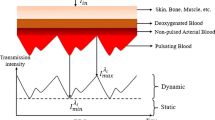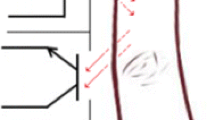Abstract
Dynamic spectroscopy (DS) theoretically eliminates individual differences and the impact of measurement conditions on accuracy and can achieve high-precision noninvasive blood component analysis. To further improve the extraction quality of DS, this paper proposes a photoplethysmography (PPG) signal waveform proportion extraction method, which realizes the extraction of DS by calculating the proportion coefficient between PPG waveforms. To verify the effectiveness of our method, the transmission spectra of 146 volunteers’ fingers and the true value of platelet content (wavelength 600–1100 nm, platelet content range 32 × 109/L–512 × 109/L) were collected. Then the DS was extracted by the single-trail method and this method, and the prediction model is established by PLS. The experimental data showed, compared with the single-trail method, that the modeling effect of the PPG waveform proportion method is significantly improved, the Rc increased 9.61%, the RMSEc decreased 31.56%, the MAPc decreased from 12 to 6%, and the Rp increased 42.92%, the RMSEP reduced 24.39%, and MAPp decreased from 13 to 11%. The results show that the PPG waveform proportion method proposed in this paper has a higher model correlation coefficient and lower prediction error, significantly improves the extraction quality of DS, further improves the accuracy of noninvasive blood component quantitative analysis, and helps to promote the application process of noninvasive detection of blood components.
Graphical abstract







Similar content being viewed by others
References
MacKenzie HA, Ashton HS, Spiers S, et al. Advances in photoacoustic noninvasive glucose testing (vol 45, pg 1587, 1999). Clin Chem. 1999;45(12):2299.
Esenaliev RO, Petrov YY, Petrova IY et al. editors. Noninvasive optoacoustic monitoring platform: clinical studies. Conference on Photons Plus Ultrasound - Imaging and Sensing 2010; 2010 Jan 24–26; San Francisco, CA2010.
Hu FH, Chen ZX, Zhang LY, et al. Vibrational imaging of glucose uptake activity in live cells and tissues by stimulated Raman scattering. Angew Chem Int Edit. 2015;54(34):9821–5.
Pandey R, Paidi SK, Valdez TA et al. Noninvasive monitoring of blood glucose with Raman spectroscopy. Acc Chem Res. 2017;50(2):264–72.
Romani A, Clementi C, Miliani C, et al. Fluorescence spectroscopy: a powerful technique for the noninvasive characterization of artwork. Acc Chem Res. 2010;43(6):837–46.
Ansari RR, Bockle S, Rovati L. New optical scheme for a polarimetric-based glucose sensor. J Biomed Opt. 2004;9(1):103–15.
Purvinis G, Cameron BD, Altrogge DM. Noninvasive polarimetric-based glucose monitoring: an in vivo study. J Diabetes Sci Technol. 2011;5(2):380–7.
Gebhart S, Faupel M, Fowler R, et al. Glucose sensing in transdermal body fluid collected under continuous vacuum pressure via micropores in the stratum corneum. Diabetes Technol Ther. 2003;5(2):159–66.
Haas J, Mizaikoff B. Advances in mid-infrared spectroscopy for chemical analysis. In: Bohn PW, Pemberton JE, editors. Annu Rev Anal Chem, vol 9. 2016. p. 45–68.
Bender JE, Shang AB, Moretti EW, et al. Noninvasive monitoring of tissue hemoglobin using UV-VIS diffuse reflectance spectroscopy: a pilot study. Opt Express. 2009;17(26):23396–409.
McMurdy J, Jay G, Suner S, et al. Photonics-based in vivo total hemoglobin monitoring and clinical relevance. J Biophotonics. 2009;2(5):277–87.
Suryakala SV, Prince S. Chemometric analysis of diffuse reflectance spectral data using singular value decomposition for blood glucose detection. Biomed Eng-App Bas C. 2018;30(5):1850027.
Li G, Li Z, Wang MJ et al. Noninvasive measurement of serum bilirubin employing near-infrared spectroscopy. Chinese J Anal Chem. 2013;41(2):263–7.
Li G, Zhao J, Li JX et al. Noninvasive prediction of red blood cell counts by normalized reflection spectroscopy for tongue inspection. Spectrosc Spect Anal. 2011;31(5):1328–31.
Wang YY, Li G, Wang HQ et al. Dynamic spectrum for noninvasive blood component analysis and its advances. Appl Spectrosc Rev. 2019;54(9):736–57.
Li G, Zhou M, Lin L. Double-sampling to improve signal-to-noise ratio (SNR) of dynamic spectrum (DS) in full spectral range. Opt Quant Electron. 2014;46(5):691–8.
Li G, Wang HQ, Zhang H et al. Equalization of whole-band signal’s SNR in the blood components noninvasive measurement. Spectrosc Spect Anal. 2012;32(2):486–90.
Ni J, Li G, Tang W, et al. Broadening the bands for improving the accuracy of noninvasive blood component analysis. Infrared Phys Techn. 2020;111:103506.
Liu A, Li G, Yan WJ et al. Combined effects of PPG preprocess and dynamic spectrum extraction on predictive performance of non-invasive detection of blood components based on dynamic spectrum. Infrared Phys Techn. 2018;92:436–42.
He WQ, Li XX, Wang MJ et al. Spectral data quality assessment based on variability analysis: application to noninvasive hemoglobin measurement by dynamic spectrum. Anal Methods-UK. 2015;7(13):5565–73.
Feng XM, Yu HX, Yi XQ et al. The relationship between the perfusion index and precision of noninvasive blood component measurement based on dynamic spectroscopy. Anal Methods-UK. 2017;9(17):2578–84.
Lin L, Zhang QR, Zhou M et al. Calibration set selection method based on the “M plus N” theory: application to non-invasive measurement by dynamic spectrum. RSC Adv. 2016;6(114):113322–6.
Biney JKM, Blocher JR, Boruvka L et al. Does the limited use of orthogonal signal correction pre-treatment approach to improve the prediction accuracy of soil organic carbon need attention? Geoderma. 2021;388:114945.
Kumar K. Orthogonal signal correction assisted PLS analysis of EEMF spectroscopic data sets: fluorimetric analysis of polycyclic aromatic hydrocarbon mixtures. Sn Appl Sci. 2020. https://doi.org/10.1007/s42452-020-2665-8.
Silalahi DD, Midi H, Arasan J et al. Robust generalized multiplicative scatter correction algorithm on pretreatment of near infrared spectral data. Vib Spectrosc. 2018;97:55–65.
Ahmadi M, Jorfi S, Birgani YT et al. Monitoring and application of artificial neural network model for prediction of organophosphorus pesticides residue in ahvaz water treatment plants. Biointerface Res Appl Chem. 2021;11(6):14032–43.
Zhang HG, Lu JG. Local regression algorithm based on net analyte signal and its application in near infrared spectral analysis. Spectrosc Spect Anal. 2016;36(2):384–7.
Zhou M, Lin L, Wang MJ et al. Influence of water on noninvasive hemoglobin measurement by dynamic spectrum. Anal Methods-UK. 2013;5(18):4660–5.
Lin L, Xiong B, Zhao SQ et al. A spectrum extraction method based on uncertainty in noninvasive blood components examinaton. Spectrosc Spect Anal. 2013;33(2):459–63.
Gang L, Li QX, Ling L et al. Discussion about the prediction accuracy for dynamic spectrum by partial FFT. Spectrosc Spect Anal. 2006;26(12):2177–80.
Li G, Xu SJ, Zhou M et al. Noninvasive hemoglobin measurement based on optimizing dynamic spectrum method. Spectrosc Lett. 2017;50(3):164–70.
Lin L, Li YC, Wang MJ et al. D-value estimation of dynamic spectrum based on the statistical methods. Spectrosc Spect Anal. 2012;32(11):3098–102.
Tang W, Chen Q, Yan WJ, He GQ, Li G, Lin L. An optimizing dynamic spectrum differential extraction method for noninvasive blood component analysis. Appl Spectrosc. 2020;74(1):23–33.
Yu Y, Yan WJ, He GQ et al. “M plus N” theory and UV-Vis-NIR transmission spectroscopy used in quantitative analysis of total bilirubin. Infrared Phys Techn. 2018;94:65–8.
Dahm DJ. Explaining some light scattering properties of milk using representative layer theory. J Near Infrared Spectrosc. 2013;21(5):323–39.
Wan XH, Li G, Zhang MQ et al. A review on the strategies for reducing the non-linearity caused by scattering on spectrochemical quantitative analysis of complex solutions. Appl Spectrosc Rev. 2020;55(5):351–77.
Zhang MQ, Fu ZG, Hou XW et al. Improving the quantitative analysis accuracy of bagged liquid components with strong scattering by multi-pathlength data fusion. Infrared Phys Techn. 2019;99:39–44.
Luo YS, Yang SQ, Tian H et al. A two-position spectral modeling method to increase the robustness of NIR analysis model. Infrared Phys Techn. 2020;104:103053.
Acknowledgements
The authors thank all those who volunteered to participate in the experiment from the Tianjin People’s Hospital.
Author information
Authors and Affiliations
Corresponding author
Ethics declarations
Ethics approval
All experiments performed were in compliance with relevant laws, as well as with the guidelines of the Tianjin People’s Hospital and the State Key Laboratory of Precision Measurement Technology and Instruments of Tianjin University. All the mentioned institutes approved the experiments. All work for this study was carried out in accordance with the code of Ethics of the World Medical Association (Declaration of Helsinki) for experiments involving humans. The volunteers gave their informed consent to participate in the study.
Competing interests
The authors declare no competing interests.
Additional information
Publisher’s note
Springer Nature remains neutral with regard to jurisdictional claims in published maps and institutional affiliations.
Rights and permissions
About this article
Cite this article
Li, G., Cheng, L., Nawaz, M.Z. et al. A method for obtaining dynamic spectrum based on the proportion of multi-wavelength PPG waveform and applying it to noninvasive detection of human platelet content. Anal Bioanal Chem 414, 5967–5977 (2022). https://doi.org/10.1007/s00216-022-04160-x
Received:
Revised:
Accepted:
Published:
Issue Date:
DOI: https://doi.org/10.1007/s00216-022-04160-x




